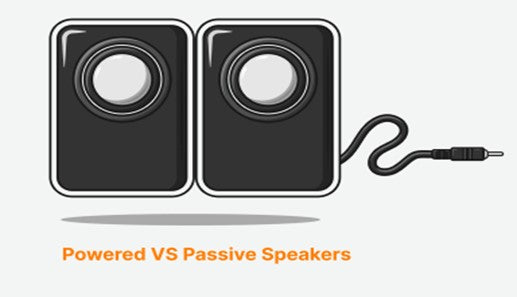
Which is Better? Powered VS Passive Speakers
Share
Speaker is not an easy-to-purchase product. People often purchase speakers for a specific reason, but there is a seemingly endless selection of designs, sizes, and pricing. Those new to speakers might find this difficult.
When purchasing speakers, one of the most important decisions you will have to make is whether you want active or passive speakers. Each speaker falls into one of these categories, and knowing the distinction between them will help you make a better decision. That's why in this article, we will tell you the pros and cons of Powered VS Passive speakers. Read on and find more information!
What Are Active/Powered Speakers?
What are active speakers? Active speakers are speakers with an embedded amplifier. They are commonly known as powered speakers since they must be plugged into an outlet or powered by a battery. They do not require other components to make sound, and audio devices can be plugged straight into them.

What Are Passive Speakers?
Passive speakers are speakers that don't have an amplifier built in. They need to be paired up with an amplifier for them to work. They get power from the amplifier, so there's no need to plug them into a power outlet or other power source. To use passive speakers, you need to connect your audio device to the amplifier.

Pros and Cons of Active/Powered Speakers
Pros:
- Setting up Active Speakers Is Easier
Active speakers are much easier to set up than passive ones. You just need to plug in your audio device, and it will work without any other components.
- Active Speakers Use Less Space Than Passive Ones
Because an amplifier is built into an active speaker, it is heavier than a passive speaker, but they take up less space. As a result, active speakers are great if you want something portable.
- Built-in Wi-Fi and Bluetooth
Active speakers often come with Wi-Fi and Bluetooth so that you can play music wirelessly. You can also use passive speakers to play music wirelessly, but you have to connect them to an amplifier that can do that. soundcore Party Speakers, like Flare and Trance Go, are examples of speakers with built-in Bluetooth.
- May Sound Better Than Passive Speakers
The reason why active speakers may sound better primarily comes down to the included amplifiers. Whereas passive speakers require an external amplifier to power them, active speakers have their own built-in amplifier, which can help to reduce distortion and noise.
Cons:
- More Expensive
Most of the time, active speakers cost more. But, it's important to remember that while passive speakers are less expensive, you still need to purchase an additional amplifier.
- Limited Customization
Active speakers have limited customization and upgrade options. For example, the amplifier cannot be replaced with a more powerful model.
Pros and Cons of Passive Speakers
Pros:
- Allow You to Choose the Amplifier
You can choose the amplifier you want to use with passive speakers. You can also experiment with various amplifiers until you discover the optimal combination for the sound that you want.
- Easier to Upgrade and Customize
It is simpler to upgrade passive speaker systems. You can upgrade the amplifier or add a component without needing to buy new speakers. For the same reason, passive speaker systems are simpler to repair.
- Available in More Sizes
Passive speakers are available in a greater variety of sizes and designs. Additionally, you can add as many as you like to a single system.
- Don't Need to Be Plugged In
Passive speakers don't need to be plugged into an outlet because they get their power from the amplifier. This lets you make a speaker system with less wiring. Active speakers require two wires: one for the audio source (unless wireless) and another one for electricity, while passive speakers get both power and audio from a single wire.
Cons:
- Not Portable
A passive speaker is useless without an amplifier. This makes the passive speaker not that portable.
- Requires Audio Knowledge
If you don't know much about audio equipment, passive speakers might not work as well as they could because the sound quality from passive speakers depends greatly on the amplifier and how the sound system is set up.
FAQ
Do DJs Use Active or Passive Speakers?
It depends, and it's more of a personal choice. Active speakers are very helpful for mobile DJs because they mean less equipment to carry around and fewer wires to mess with. On the other hand, passive speakers work better in a club where the sound system can be powered by a rack of amplifiers.
How Long Do Passive Speakers Last?
A good pair of passive loudspeakers can last a lifetime, which is one of their best features. Passive loudspeakers don't have any technological limits built in like many powered and active loudspeakers do.
Do Passive Speakers Need an Amplifier?
Yes, a passive speaker doesn't have a built-in amplifier, so it needs to be wired to your amplifier. However, they get their power from the amplifier, so you don't have to plug them into a battery or a power source.
Which Is Right for You?
After reading the above content, you should already be aware of the distinctions between Active and Passive speakers. Are Active or Passive speakers better? You may wonder. Actually, it's a matter of personal preference. Active and passive speakers frequently serve the same function.
Active speakers are perfect if you want something that is simple to set up and requires no additional components. Because it has a built-in amplifier, you can rest assured that everything has been optimized for optimal sound quality. Meanwhile, passive speakers offer more possibilities and enable customization of the audio system. Passive speakers are better if you want a certain type of amplifier or if you want to be able to upgrade.